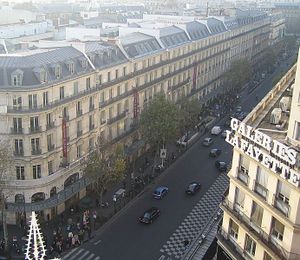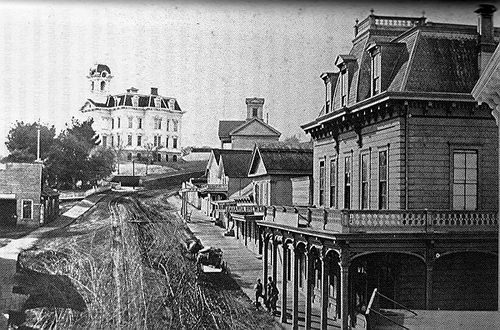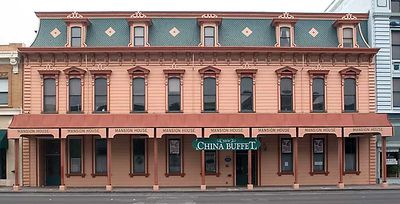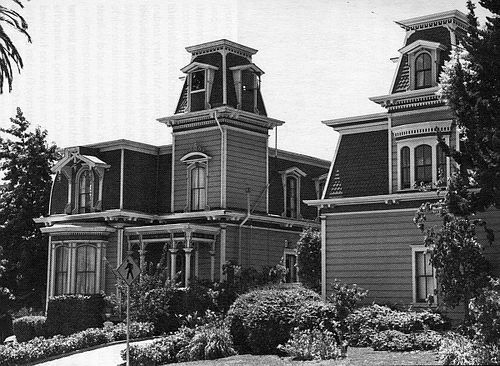History Pages: 32 – Paris on the San Lorenzo: Second Empire style
For a table of contents, see History pages.
The 1870s is a good time to make a slight diversion into architectural history. Earlier posts in this blog used “names on the signs” as an entry point into a study of Santa Cruz history, but the most visible remnants of a historical period are usually its buildings and other human constructions. They don’t move around like people, and are big enough to be hard to ignore.
With a little study, it’s often possible to guess approximately when a local structure was built, and that’s especially true for some of the handful of buildings constructed in a very distinctive and easily recognizable style called Second Empire. The Second Empire style came and went very quickly. Virtually all of the local examples, whether they still stand or not, were built during a nine-year period from 1873 to 1882.
Where did the name Second Empire come from? In 1852, after being elected president of the Republic of France, Louis-Napoléon Bonaparte (nephew of Emperor Napoléon I) declared himself Emperor Napoléon III (a popular move at the time) - creating the Second Empire of France. Why was he Napoléon III rather than Napoléon II? No time for that story here – look it up.
The second Emperor had some of the same hubris that doomed his famous uncle, and his reign came to an abrupt end when he picked a fight with Prussia in 1870. France suffered total defeat, Prussian occupation and national humiliation. After six months as a Prussian prisoner-of-war, the former emperor spent the rest of his life in exile. Not surprisingly, anything that recalled the Second Empire suddenly went out of fashion.
What is Second Empire style? If you’ve ever been to Paris, you’ve seen a lot of it. It’s the dominant style of the buildings that line the grand boulevards of the city, most of which were built or widened during the period from 1852-1870. Prefect Baron Haussmann, the emperor's right-hand man in Paris, held unprecedented city-shaping powers during the period, to an extent our local city planners can only dream of (just kidding, planners).
Haussman was very German for a Frenchman (born in the Alsace border region) - he valued order, straight lines and long views. You can see these impulses at work in the photo showing a long row of nearly identical buildings on Boulevard Haussmann. Americans were never willing to give government that much power, so we find the style applied to individual buildings.
The most distinctive feature of the style is the roof. Parisian building designers of the 1850s had to deal with some restrictive zoning standards. There was a height limit, and also a requirement that roofs have a steep roof angle (at least 45° - to match older buildings). Both of those restrictions actually pre-dated the Second Empire, but Hausmann's redevelopment program applied them to large numbers of both new and older buildings along major new streets.
That steep roof angle creates a very tall pointy roof, and landlords hated to lose that much rentable space. So someone came up with the clever idea of breaking the roof into two different slopes. The lower roof had the required steep slope, while the upper roof was almost flat – thus keeping the overall height under the limit. Et voilà, the mansard roof was born. Nearly a full extra story could be fitted under a mansard roof, with windows provided by use of dormers. The low-ceilinged attic rooms thus created are the famous garrets immortalized by penniless artists and poets. In those days before indoor plumbing and elevators, the top floor had the lowest rent.
In the US, as always, news and styles from Europe traveled more slowly, and more slowly still from the East Coast to the west. In sleepy Santa Cruz, the style was just getting started as the French army went down to defeat at Sedan in 1870. Second Empire became the first in a series of local architectural styles that are grouped together under the name Victorian. The American adaptation of the Second Empire style left out many features characteristic of the style in Paris and retained some American bits (e.g. covered street-front porches), but the mansard roof with dormer windows is found in every example.
We've already talked about a couple of Second Empire-style buildings in How the Town Became a City. The first was the St. Charles Hotel, built on Mission Street in 1868. The St. Charles got its French makeover in 1873, when a 3rd floor was added - under a mansard roof (seen at far right in this 1880 photo, looking up Mission Street). That same year saw construction of the Oddfellows Building, from which the cupola tower (another common Second Empire feature) survives as our Town Clock. In 1875, Mission Hill School was rebuilt in the new style, complete with cupola (on the horizon in the photo at right).
After 1875, the style briefly became a favorite for new hotels. The Riverside, the Bayview in Aptos and the Mansion House in Watsonville were all built between 1775 and 1780. Fortunately for historic architecture buffs, the Bayview and Mansion House (photo left) have survived the changing times and the 1989 earthquake.
Only one Santa Cruz residential example still stands, but it’s a very good one - the 1882 McPheters house on Escalona Street (right). The house has been lovingly restored, and local architect Mark Primack designed the complementary carriage house, which looks like it was also built in 1882 instead of more than a century later.
It’s unfortunate that 20th-century commercial buildings have given the mansard such a bad name. Instead of a clever and attractive way to expand usable top-floor space, near-vertical mansards are stuck on to break up expanses of featureless stucco walls. Luckily, we’ll always have Paris.
Sources
- Carmona, Michel, and Patrick Camiller. Haussmann: His Life and Times and the Making of Modern Paris (2002)
- Chase, John L. Sidewalk Companion to Santa Cruz Architecture (3rd ed. 2005). One of my few criticisms of Chase’s invaluable book is that he didn’t include Second Empire in its list of architectural styles, even though the style name is mentioned in one or two building descriptions. In the 4th edition, that oversight will be addressed.
- McAlester, Virginia and Lee. A Field Guide to American Houses (2000)




